![]()
![]()
![]()
Use LEFT and RIGHT arrow keys to navigate between flashcards;
Use UP and DOWN arrow keys to flip the card;
H to show hint;
A reads text to speech;
61 Cards in this Set
- Front
- Back
|
techniques for membrane fluidity
|
1)Fye and Ediden exp (not in real cells)
2)FRAP (real cells) 3)single particle tracking (real cells) |
|
|
single particle tracking
|
|
|
|
what about integral membrane proteins with large extracellular domains?
|
can find themselves entangled in the extracellular matrix
|
|
|
proteins anchored to membrane will what?
|
not diffuse
|
|
|
just beneath membrane lies what?
|
network of fibrous proteins...membrane skeleton
|
|
|
what is the membrane skeleton often formed by?
|
spectrin and actin filaments and associated proteins
|
|
|
what is the makeup of A RBC membrane skeleton?
|
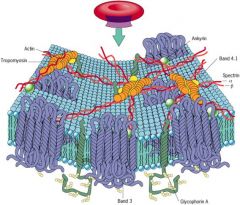
spectrin
actin tropomyosin ankyrin Band 4.1 |
|
|
what happens as a reslt of anchoring of proteins and mobility barriers presented by the membrane skeleton?
ex? |
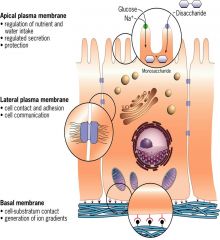
cells can maintain plasma membrane domains that differ in composition and function
epithelial cells in gut have: |
|
|
what do most simple diffusion equations describe?
|
net influx or efflux
|
|
|
diffusion
|
net movement of solute down its electrochemical gradient
|
|
|
electrochemical gradient
|
sum of concentration gradient and electrical gradient
|
|
|
concentration gradient
|
difference in concentration of a solute in one region compared to another
|
|
|
electrical gradient
|
force acting on a charged solute molecule as it moves from a region with one electrical potential to a region with a deifferent electrical potential
|
|
|
is diffusion spontaneous or non-spontaneous
|
spontaneous...negative ΔG
|
|
|
what causes movement of substances across membranes-diffusion- to be spontaneous and have a -ΔG
|
|
|
|
Why do we have to introduce charge and electrical potentials into our concept of diffusion?
|
|
|
|
Direction of net movement of uncharged solute across a cell membrane is what?
|
always down solute's concentration gradient
|
|
|
ΔG relating to diffusion of uncharged molecules
|
|
|
|
ΔG relating to diffusion of charged molecules
|
|
|
|
What can ΔG for ion movement across a membrane tell us?
|
1) Is the movement of a solute or ion across a membrane passiveor active?
|
|
|
what does ΔG (net movement into cell) not tell us
|
|
|
|
In order for solutes to enter cell....
|
must pass through the partial permeability barrier created by the membrane
|
|
|
lipids, small uncharged polar molecules, large uncharged polar molecules, charged molecules of any size and how they diffuse through membrane
|
|
|
|
what is the name relating to diffusion given to the membrane?
|
semipermeable barrier...must be able to maintain concentration differences between the internal and external environments
|
|
|
health of cell and diffusion
|
requires that material transport be a regulated process
|
|
|
What is the difection of movement of material across a membrane?
|
moves in both directions
|
|
|
most cell products are what?
...importance with diffusion |
charged or polar....cells have evolved membrane proteins whose function is to transport small molecules and ions
|
|
|
2 basic types of movement across cells
|

-passive transport
-active transport |
|
|
passive transport
|
In passive transport, molecules move spontaneously down their electrochemical gradient (–ΔG).
|
|
|
active transport
|
In active transport, energy (ATP) is consumed to move molecules up their electrochemical gradient –similar to a “coupled reaction”
|
|
|
simple diffusion
|
molecules just diffuse across the bilayer down its electrochemical gradien-no transport protein or channel is involved
|
|
|
three factors combine to limit simple diffusion
|
|
|
|
can simple diffusion be saturated?
|
no..there is no limit to the net flux as the electrochemical gradient increases
|
|
|
simple diffusion of water across membrane?
|
osmosis
|
|
|
how does osmosis work
|
water goes from area of low solute concentration to one of higher solute concentration
cell volume and turgor pressure can be controlled by solute concentration...turger pressure is greater the more hypotonic the environment is |
|
|
3 osmosis conditions
|
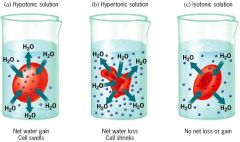
a
|
|
|
mneumonic for osmosis
|
hypooooooo.....the o looks like a filled up cell
|
|
|
what do pore or channel proteins do?
|
allow ions, charged and some uncharged polar molecules to cross the membrane by passive diffusion
...not simple diffusion since a channel protein is involved |
|
|
Ion channels can allow what with respect to flux
|
bidirectional flux or specific ions... Na, K, Ca, Cl across a membrane down their electrochemical gradients
|
|
|
channel protein water can move through
|
aquaporin
|
|
|
channel structure
|
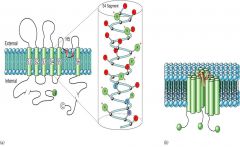
|
|
|
are ion channels selective or not selective?
|
very selective-only allow one type of ion to pass through
|
|
|
what does a pore (ion channel) look like
|
|
|
|
describe what happens to ion as it enters goes through channel
|
|
|
|
are ion channels always open?
|
no...Ion channels are not always open -the central pore can be “gated”open and shut by changes in channel conformation.
|
|
|
change in conformation that opens a channel can be driven by?
|
|
|
|
a given channel protein can be named by
|
|
|
|
ligand gated channels
|
|
|
|
extracellular ligands
|
water-soluble hormones, neurotransmitters
|
|
|
intracellular ligands
|
|
|
|
resting membrane potential of most animal cells and plant cells
|
-60 to -70mV
|
|
|
ligands do what to membrane potential?
|
change it by allowing stuff in or out of the gate.
|
|
|
is the movement of ions saturable through a pore?
|

no; however, binding of the ligand is and it displays affinity to the receptor: similar to michaelis-menton equation..
Kd=1/affinity of the channel for the ligand %with ligand bound=[ligand]/(Kd+[ligand])*100% |
|
|
Kd=
|
K-1/K1
or 1/affinity of the chanel for the ligand |
|
|
for many channels________ eqyals % open
|
percent chanels with ligand bound
|
|
|
picture of ligand gated mechanism
|
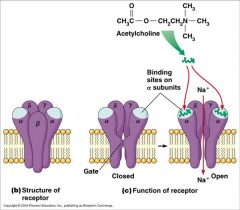
.
|
|
|
voltage gated ion channels do what?
|
open up when there is a change in the membrane potential
|
|
|
generally speaking, if the membrane potential starts at -70mV and becomes more positive....what will happen?
|
it will let stuff in
|
|
|
what creates action potential in nerve cells?
|
voltage-dependent sodium and potassium chanels
|
|
|
what happens if voltage gated ion channels Ca2+ are present?
|
will allow calcium ions to flow into the cell.
|
|
|
what does the transmembrane helices S4 contain and why is this importatn?
|
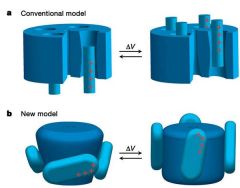
it contains many positively charged arginine residues ....if the cell becomes positively charged inside...these residues will repel the positive charge, move through the membrane, and create a conformational change that will open the pore.
|

